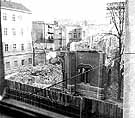
|
|
|

|

|

|

|
|
Click on an image to see a larger, more detailed picture.
|
|
|
|
|
| 1943: Death and Resistance |

|
pg. 476 |

|
|
|
|
| |
 The Jewish synagogue in Zagreb, Croatia, was demolished in 1943. The onslaught against Croatian Jewry that began in 1941 with the German invasion of the Soviet Union continued into 1943. Deportations from Zagreb were personally ordered by Heinrich Himmler in May 1943, and the vast majority of Croatian Jews who were sent to Auschwitz never emerged. Most Croatian Jews who died, however, were killed not by the Nazis but by the country's ruthless Ustasa regime.
The Jewish synagogue in Zagreb, Croatia, was demolished in 1943. The onslaught against Croatian Jewry that began in 1941 with the German invasion of the Soviet Union continued into 1943. Deportations from Zagreb were personally ordered by Heinrich Himmler in May 1943, and the vast majority of Croatian Jews who were sent to Auschwitz never emerged. Most Croatian Jews who died, however, were killed not by the Nazis but by the country's ruthless Ustasa regime.
Photo: Jewish Historical Museum of Yugoslavia / United States Holocaust Memorial Museum Photo Archive
|
 Ignacy Isaac Schwarzbart was a Zionist member of the Polish Parliament and the Polish government-in-exile. He published a Jewish newspaper, The Future, in London, documenting the German Holocaust against Jews in Poland. Like all such information going to the Allies, his newspaper had little effect on Allied disinclination to rally aid for Jews. Schwarzbart opposed bombing Auschwitz, fearing that too many Jews would lose their lives to Allied attacks.
Ignacy Isaac Schwarzbart was a Zionist member of the Polish Parliament and the Polish government-in-exile. He published a Jewish newspaper, The Future, in London, documenting the German Holocaust against Jews in Poland. Like all such information going to the Allies, his newspaper had little effect on Allied disinclination to rally aid for Jews. Schwarzbart opposed bombing Auschwitz, fearing that too many Jews would lose their lives to Allied attacks.
Photo: Striat Hapoalim/ Yad Vashem
|
|
Art as Resistance In the midst of degradation and despair, concentration-camp prisoners refused to allow their creativity to be stifled and destroyed. Even as they struggled to survive, prisoners used whatever scraps of paper and stubs of pencils they could find to express themselves. Through poetry and art, they affirmed their own existence and documented the horrors they feared might be forgotten. In Theresienstadt, the model camp/ghetto the Nazis established near Prague, Czechoslovakia, artists such as Felix Bloch produced "official" art on command while secretly creating works that portrayed Jewish existence as it was. Teacher Friedl Dicker-Brandeis nurtured the talents of her young Theresienstadt charges, enabling them through art to transform the dark and dangerous world of the Nazis into a realm of light and love. The drawings the children left behind portray images of butterflies and birds, sailboats and family gatherings. But they also record the trauma of daily life, ghetto guards, and train departures to the death camps. One child's poem voices the longing reflected in the drawings of many: "I'd like to go away alone/Where there are other, nicer people/Somewhere into the far unknown/ There, where no one kills another."
|
|

|

|

|

|
 September 1943: Hundreds of Jews escape from Vilna, Lithuania, and head east toward the Soviet front line.
September 1943: Hundreds of Jews escape from Vilna, Lithuania, and head east toward the Soviet front line.
|
 September 1943: Vilna-based partisan Vitka Kempner blows up an electrical transformer located in the city. A day later, she enters the labor camp at Keilis, near Vilna, and smuggles several dozen prisoners to safety. Still later, she travels with five other partisans to Olkiniki, Poland, where she helps torch a turpentine factory.
September 1943: Vilna-based partisan Vitka Kempner blows up an electrical transformer located in the city. A day later, she enters the labor camp at Keilis, near Vilna, and smuggles several dozen prisoners to safety. Still later, she travels with five other partisans to Olkiniki, Poland, where she helps torch a turpentine factory.
|
 September 1943: In Paris, three Jewish partisans ambush and assassinate Karl Ritter, aide to Nazi slave-labor chief Fritz Sauckel.
September 1943: In Paris, three Jewish partisans ambush and assassinate Karl Ritter, aide to Nazi slave-labor chief Fritz Sauckel.
|
 September 1943: After refusing for months, the Hungarian government accedes to German demands for Jews to be used as slave labor at copper mines at Bor, Yugoslavia.
September 1943: After refusing for months, the Hungarian government accedes to German demands for Jews to be used as slave labor at copper mines at Bor, Yugoslavia.
|
|
|
|
|
| 1943: Death and Resistance |

|
pg. 476 |

|
|
The Holocaust Chronicle
© 2009 Publications International, Ltd.
|
|
